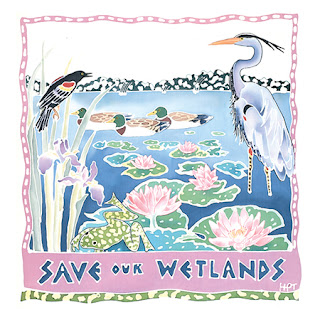The EPA defines wetlands as “lands where saturation with
water is the dominant factor determining the nature of soil development and
they types of plant and animal communities living in the soil and on its
surface.” Hydrology, the presence of water in an area for a certain period of
time, is one of the defining factors of a wetland. This also includes saturated
soils and soils that have been without oxygen for an extended period of time.
Wetlands include swamps, marshes, and bogs that feed
downstream waters, trap floodwaters, recharge groundwater supplies, removed
pollution, and provide fish and wildlife habitat. Along with this, wetlands are
known as economic drivers because of the significance played in fishing,
hunting, agriculture and recreation. More often than not, wetlands are found alongside waterways
and flood plains, but this is not always the case. Wetlands may also provide
critical groundwater connections while having no connection to surface
waterways. Variance is common among wetlands with differences in soils,
topography, climate, hydrology, water chemistry, and vegetation.
 Wetlands are among the most productive environments and play
a significant role. They are essential to: all life on earth, the water cycle, maintaining
diverse ecosystems, humans, and providing food, timber, drinking water, and
medicines. Wetlands provide storage for storm water runoff which in turn
provides water of greater quality to reach downstream. The deepest part of the
wetland creates a zone for sediment to settle. At the deepest zone, the water
moves slowly and toxins and pollutants attached with that sediment are able to
stay in one area. This is where most of the floating plants, such as water
lilies and pong weed, will reside because the roots attach deep into the soil.
In the shallow zone is where nitrogen removal, or de-nitrification, occurs.
There is a lack of oxygen in this part of the soil and anaerobic microbes
transform the nitrates from the runoff into nitrogen gas. This is an essential
role of a wetland because the nitrogen is released back into the atmosphere
before it can be run downstream in the water as a potential pollutant. Along
the edges, rich plant communities help keep the soil in tact from the erosion
of high tides. These plants have strong root systems. These plant communities
are also vital for insects. Insects will take care of the mosquitoes and any
existing mosquito population. The consequences correlating with the loss of
wetlands includes climate change, flooding, drought, pollution, and species
loss.
Wetlands are among the most productive environments and play
a significant role. They are essential to: all life on earth, the water cycle, maintaining
diverse ecosystems, humans, and providing food, timber, drinking water, and
medicines. Wetlands provide storage for storm water runoff which in turn
provides water of greater quality to reach downstream. The deepest part of the
wetland creates a zone for sediment to settle. At the deepest zone, the water
moves slowly and toxins and pollutants attached with that sediment are able to
stay in one area. This is where most of the floating plants, such as water
lilies and pong weed, will reside because the roots attach deep into the soil.
In the shallow zone is where nitrogen removal, or de-nitrification, occurs.
There is a lack of oxygen in this part of the soil and anaerobic microbes
transform the nitrates from the runoff into nitrogen gas. This is an essential
role of a wetland because the nitrogen is released back into the atmosphere
before it can be run downstream in the water as a potential pollutant. Along
the edges, rich plant communities help keep the soil in tact from the erosion
of high tides. These plants have strong root systems. These plant communities
are also vital for insects. Insects will take care of the mosquitoes and any
existing mosquito population. The consequences correlating with the loss of
wetlands includes climate change, flooding, drought, pollution, and species
loss.
Ramsar, or The Convention on Wetlands, is an intergovernmental treaty that serves to conserve wetlands and their resources. Ramsar was started in November of 1962, enforced in 1975, and is one of the oldest of modern global environmental agreements. There are 169 countries bound to the contract and 2,216 total Ramsar sites. The United States houses 35 of 2,216 sites with 5 in New England, 13 in the Midwest, 7 in the West, and 10 in the South.
There is one site located
at the Wilma H. Schiermeier Olentangy River Wetland Research Park in Columbus,
Ohio. There is a complex of created and natural freshwater riverine wetlands
that include tree-dominated wetlands. Wetland Research Park has a biologically
diverse ecosystem that inhabits the river with both representative and unique
species to the region. To date, the site has supported almost 160 bird species,
diverse fish and invertebrate communities in the river and marshes, and a wide
variety of mammals, amphibians, and reptiles. This was achieved in an urban
setting with 1.6 million people. This is a significant outreach for an urban
community such as Columbus where few wetlands remain.
Source:


